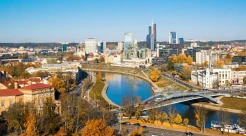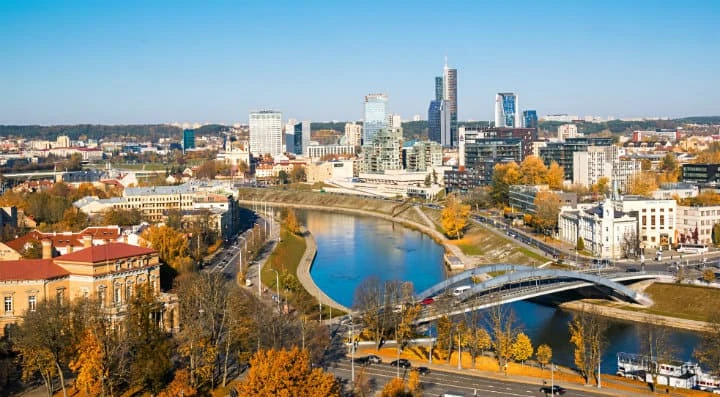
Gay Vilnius · City Guide
First visit to Vilnius? Then our gay Vilnius city guide page is for you.
Book A Travel Gay Approved Hotel

Vilnius
The capital and largest city of Lithuania. Vilnius is home to over 500,000 people and is the second largest city in the Baltic States.
The city started life as a trading settlement and has a rich and varied history. The city was part of the Polish-Lithuanian Commonwealth, the Russian Empire and the Soviet Union. Prior to World War II, Vilnius was known as the Jerusalem of Lithuania due to its large Jewish population.
Today, Vilnius has a diverse economy that reaches across a variety of sectors. Tourists are drawn to the city for its historic buildings, interesting culture, upscale shopping and modest gay scene.
Gay Rights in Lithuania
Like many countries in Eastern Europe, attitudes and laws regarding LGBT citizens are behind other states in Europe. Despite an equal age of consent (16), there is no recognition of partnerships for same-sex couples and public consensus is generally opposed to equal marriage rights.
As Lithuania is sparsely populated, it is rare to find gay scenes except for in the cities of Vilnius, Kaunas and Klaipėda. Attitudes in the cities tend to be more liberal in comparison to more provincial towns, however some discretion is advised when out in public.
Gay Scene
Vilnius has a modest gay scene with a dance club, sauna, and cafe for gay customers. There is no specific gay area, and some of the venues are on opposite ends of the city centre.
The Baltic Pride is the official Pride celebration for the three Baltic States (Estonia, Latvia, Lithuania), and it rotates between the three capitals (Tallinn, Riga, Vilnius). The next event will be held in Riga in 2018.
Getting to Vilnius
By plane
Vilnius Airport (VNO) is located around 6km from the city centre. It is a hub for AirBaltic and several other budget airlines. It offers routes to most major cities in Europe as well as to some destinations in North Africa and the Middle East.
There is a train service that takes you directly into the city centre that leaves 16 times a day. Single tickets cost 0.70 euros and the journey takes around 7 minutes. Tickets can be bought online, on the train or at the railway station.
There are bus and micro bus services that leave from the airport into the city centre. Single journeys cost €1 and journey times are only slightly longer than if travelling by train. Buses may be the better option as they take you to a wider range of locations in the city centre.
You can order a taxi in advance but the taxi rank at the airport is well regulated and reasonably priced. Journeys to the old town should cost around €10 and will take just over 5 minutes, depending on traffic or roadworks.
By train
Vilnius train station is located south of the downtown area and offers a range of national connections as well as connections to neighbouring Russia and Belarus.
By bus
Vilnius is at the heart of the national bus network with journeys across Lithuania being relatively short. There are longer international bus routes operated by Eurolines, ECOLINES and Polski Bus that offer cheap (but longer) connections to the other Baltic States and their European neighbours.
Getting around Vilnius
On foot
Despite Vilnius' old town being one of the largest in Europe, it is still easy to get around on foot. This is probably the best way to take in the sights and the architecture, especially on a pleasant summer's day.
By public transport
Vilnius Transport is responsible for the bus and trolley bus network. Singles cost €1 and must be purchased from the driver with cash (although this cheaper if you purchase a Vilnius Citizen Card). Tickets must be validated immediately on arrival. There are night bus services on weekends.
By taxi
Taxis can be hailed on the street, but quite often they will be double the price than if you pre-ordered them. They are renowned for ripping off tourists. Many locals use taxi apps which can be cheaper than using the regular companies.
Where to Stay in Vilnius
For a list of recommended hotels Vilnius, please visit our Gay Vilnius Hotels page.
Things to See & Do
Gediminas' Tower - iconic tower named after a Grand Duke of Lithuania. A brick tower has stood on this hill since 1409 and was rebuilt in 1930. You can either walk or take a funincular to the top.
The Old Town - Vilnius' historic heart. This area is a labyrinth of Baroque, Renaissance and Gothic architecture. It was also the location of the Warsaw ghetto during the Nazi occupation. Today there are plenty of restaurants, boutiques and sights to entertain visitors.
Vilnius Cathedral - the beautiful classical cathedral was constructed between 1783 to 1801. It is free to visits but entry is restricted during mass. You can also visit the crypts however you must be accompanied by a guide.
Literatų gatvė (Street Of Writers) - this street has artistic dedications to writers and authors with a connection to Vilnius. You may be surprised at some of the names that crop up here.
Vilna Gaon State Jewish Museum - this museum was originally opened in 1913 but was closed in 1949. After reopening in 1991, this museum tells the sombre story of the Jews of Lithuania.
Lithuanian Opera and Ballet Theatre - an impressive modern building. Why not take in a performance by the companies in residence.
Road of Freedom - an abstract sculpture celebrating Vilnius' independence from the Soviet Union. It represents the chain of people who held hands across the Baltic States.
Užupis - the hipster/bohemian area of the city. Here you will find a large concentration of quirky independent shops, bars and galleries.
When to Visit
Summer in the city is characterised by pleasant, warm weather and the occasional heatwaves. Winters are cold, and temperatures below -25°C are not unheard of. Late spring and summer are the best times to visit as the city is full of life.
There is a wide variety of festivals and events throughout the calendar to keep visitors entertained. From the middle of March to the beginning of April, the international film festival takes place. The Vilnius Jazz Festival is known for its innovation and creativity.
Visa
Lithuania is within the Schengen visa area. As it is part of the European Union, its visa requirements fall inline with what you would expect from most EU states.
Money
Lithuania is part of the eurozone. There is a good selection of banks and currency exchangers to choose from. Most larger stores, restaurants and hotels accept card payments, but it is always a good idea to keep some cash on you just in case.
Join the Travel Gay Newsletter
Have we got something wrong?
Are we missing a new venue or has a business closed? Or has something changed and we have not yet updated our pages? Please use this form to let us know. We really appreciate your feedback.